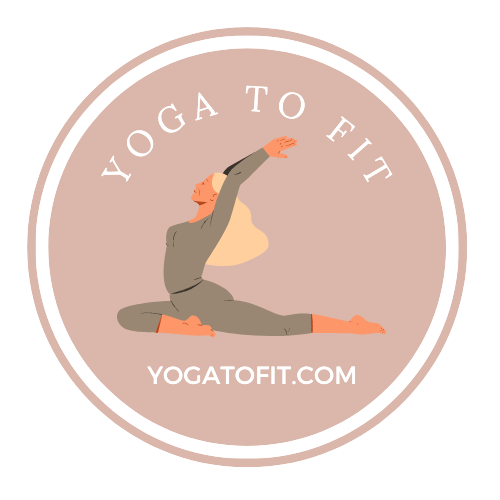Best Yoga Practices for Kids
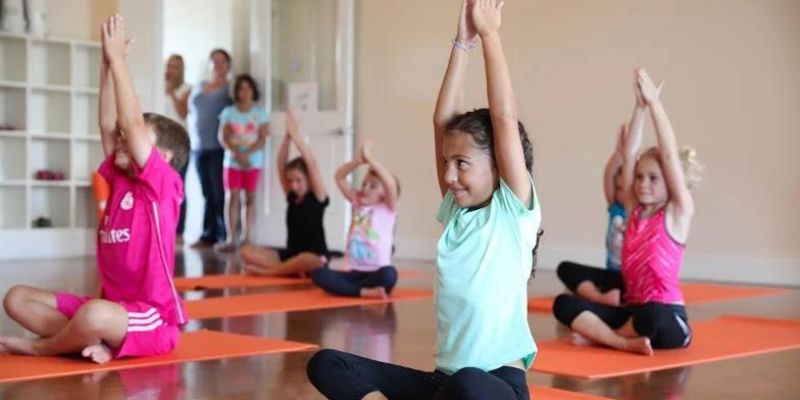
Yoga is for everybody whether you are a kid, a teenager, an adult, or a senior citizen. Yoga can be practiced by any age group. Only exercises differ according to the age of the person performing them. Yoga is an activity that includes breathing techniques, yoga poses, and mindfulness. Yoga Practices for kids and adults make them more active, flexible, and mindful to enhance their overall well-being!
What kids need is movement, fun, exercise, and entertainment and Yoga has this all. It is important nowadays to encourage kids to play with yoga props and exercise more. Encourage them to be healthy and eat healthy. Yoga and meditation help in making kids active, and more conscious about their bodies and healthy lives. Here’s a guide on yoga poses and yoga practices for your children. These yoga practices for kids are fun and child-friendly, have a look!
Benefits of Yoga Practices for Kids
Yoga Practices for kids have a great benefit for them and their health. These benefits include:
- Sensory input
- Balance
- Release of excess energy
- Helping with anxiety/depression
- Better sleep
- Focus
- Relaxation
- Stress reduction
- Better alignment of the body/posture
- Increased strength
How to Introduce Yoga to Kids?

Yoga practices for kids are very different as compared to adults. Yoga practices for kids can be done in the form of storytelling, singing songs, dancing, playing games, and even watching TV. Some schools have also introduced Yoga in their curriculum all over the world but still, some children are lacking behind and don’t know what is yoga, how to perform and what is its role in our lives. But need not hesitate, yoga practices for kids can be performed anywhere at school, outside the school, on the playground, at home, in an open space, etc.
One thing is necessary to remember that kids should perform yoga practices with their family at home and with their trainer at school under their supervision. Yoga practices for kids have a positive impact on kids and learning. Let’s understand how we can introduce Yoga practices to kids for the first time:
1. Lead by Example
Children often learn from their parents or guardians. So, try practicing yoga together with your kids so that they see and learn from you which will create a bonding and a wonderful experience of practicing Yoga.
2. Choose Age-Appropriate Classes
Always look for local yoga classes that are specifically run for kids. These classes include storytelling, games, and songs along with yoga practices to make it a fun and engaging activity.
3. Online Resources
There are a number of online resources and videos that are specifically created or designed for kids’ yoga. Platforms like YouTube offer a wide range of yoga sessions for different age groups accordingly.
4. Create a Calm Environment
Just make sure there’s a quiet and calm space for yoga at home. Yoga practices for kids require a peaceful environment as it directly affects kids’ physical as well as mental health and kids will be more focused in such environment. Colorful mats and props can be used in order to make the yoga practice more enjoyable and fun-loving.
5. Make It Playful
Kids love to play more than anything and including playful elements in their yoga sessions would be a better idea like animal-themed poses or creating an adventure story to make it more interesting for kids.
6. Respect Their Pace
Children are not able to hold poses as long as adults can so encourage them to do their best without pushing themselves too hard. Provide them required rests in between so that their energy level and stamina would be maintained during the session.
7. Encourage Regular Practice
Try to make a routine of regular yoga practice for kids so that they become habitual of it, even if it is for a few minutes every day. This will include a physical activity in their schedule activity which is an important part of everyone’s life in today’s world.
8. Celebrate Achievements
Also, celebrate your child’s progress, no matter how much he achieves. This will create a positive attitude in your kid and boost their confidence and motivation.
Read More: Best Yoga Mats for Toddlers in 2023
Yoga Practices for Kids
Yoga practices for kids are somewhat different from adults but these poses can be performed by any age group. Let’s have a look:
1. Easy sitting pose (Sukhasana)
This is one of the easier poses to do. It involves sitting up straight with the legs crossed. This yoga pose provides relaxation to your body and increases focus. It also strengthens the muscles in your back and increases flexibility in the legs and hips.

How to do this pose:
- Sit on the ground with the back nice and tall.
- Cross the legs, bringing the knees toward the ground.
- The hands can be on the knees facing up, or they can be together at the heart center.
- This pose can be held for multiple breaths or when meditating.
2. Child’s pose (Balasana)
The child’s pose is another simple pose to do for kids, as the name suggests. It involves sitting back on the heels and folding forward, bringing the arms out in front of the body, and resting the forehead on the ground.
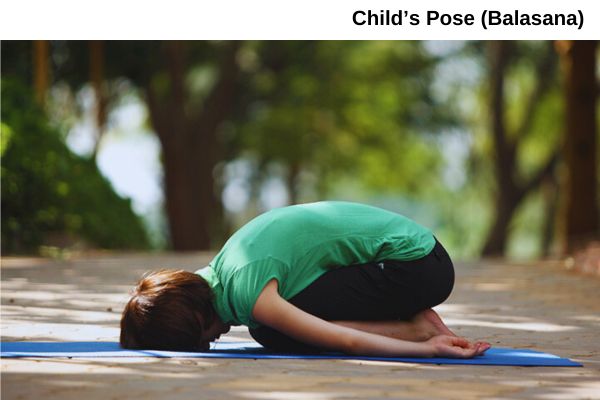
How to do this pose:
- Start on the hands and knees.
- Press the hips back toward the heels.
- The arms can be stretched out in front of the body or curled down by the sides.
3. Half-Lotus Pose (Ardha padmasana)
The half-lotus pose is a version of the lotus pose and provides the advantages of the full pose. It is important to note that this pose should be done on both sides of the body to get equal results on each side.

How to do this pose:
- Sit down on the ground.
- Fold the legs in front of the body.
- Bring one leg on top of the other, flexing the feet.
- Do the same on the other side.
4. Cobra pose (Bhujangasana)
When doing this pose, make sure kids should only press as far as they can go using the muscles in the back. This prevents overextending and keeps the body safe. This is a very fun-loving practice for kids, and it usually ends with lots of giggles.

How to do this pose:
- Start on the belly.
- Bring the hands flat to the ground under the shoulders.
- Using the back muscles and the core, lift up.
- Hold the pose for a few breaths.
5. Wide-angle seated forward bend (Upavistha Konasana)
Kids can perform this yoga pose with you in front of them. They will love to do this yoga practice as both of you can join hands and carefully take turns pulling each other deeper into the pose.
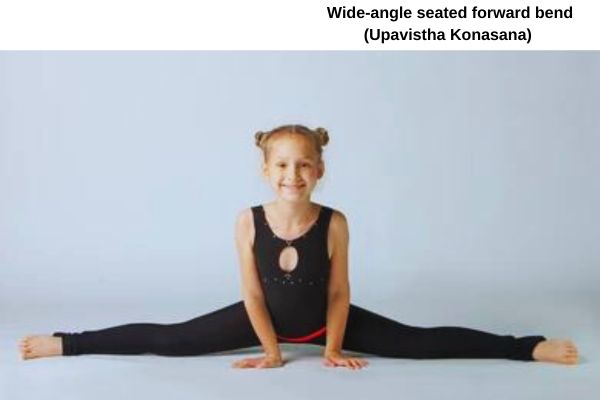
How to do this pose:
- Bring the legs out in front of the body, flexing the feet.
- Bring the arms up.
- Fold forward as far as comfortable.
- If the feet cannot be reached, reach for the legs.
- Hold for a few breaths.
6. Butterfly pose (Baddha Konasana)
This is one of the popular yoga practices for kids. It allows for super fun bonding experiences, especially between parents and their kids.

How to do this pose:
- Sit on the ground with the feet together and the knees out to the sides.
- This pose can be held while flapping the legs like butterflies or while breathing deeply.
- Hold for a few breaths.
7. Tree pose (Vrksasana)
The tree pose is often a favorite among children. Kids often turn this pose into a competition to see who can hold it the longest.

How to do this pose:
- Shift the weight into one foot and bring the other foot to the ankle, shin, or thigh.
- Bring the arms up or the hands together at the chest.
- Focus on an unmoving spot or object.
- Hold for a few breaths.
- Do the same to the other side.
8. Seated forward fold (Paschimottanasana)
This yoga practice is similar to the wide-angle seated forward bend. The difference is just that instead of having the legs out to the sides, the legs are out in front of the body, creating a much different stretch.

How to do this pose:
- Bring the legs out in front of the body, flexing the feet.
- Bring the arms up.
- Fold forward as far as comfortable.
- If the feet cannot be reached, reach for the legs.
- Hold for a few breaths.
9. Warrior I (Virabhadrasana I)
Warrior I yoga pose emphasizes balance, strength, and focus. It is a great pose to do with kids.

How to do this pose:
- Step into a high lunge, bending the front leg at a 90° angle.
- Bring the back foot flat to the ground at a 45° angle.
- Bring the arms up to the sky, keeping the hips squared.
- Hold for a few breaths.
10. Corpse pose (Savasana)
The corpse pose is a very simple pose to do. It only involves lying flat on the ground with the arms by the sides and the legs straight out in front of the body. Kids can easily do this yoga pose.
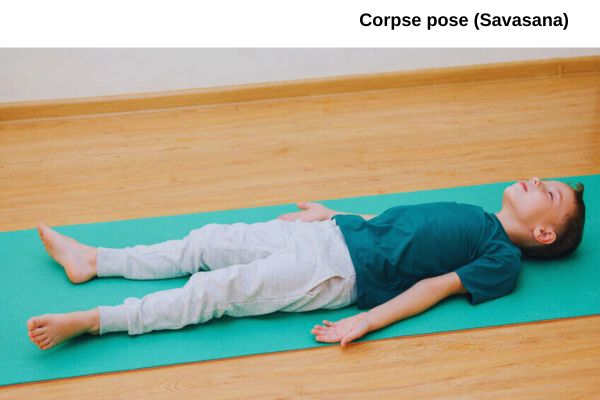
How to do this pose:
- Lie on the ground with the arms by the sides and the legs out in front of the body
- Hold this pose during meditation or deep breathing exercises.
Conclusion
Yoga Practices for kids are an excellent way to introduce healthy habits and mindfulness from an early age. By making your child do yoga, you provide them with its values as well as physical and emotional well-being that can last a lifetime. Yoga increases focus and decreases anxiety in children at an early age of children. Yoga practices for kids are a powerful tool for them to have as they face the stresses of school, social drama, and peer pressure, in today’s time.
FAQs
Q1. At what age can children start practicing yoga?
Children as young as 3 or 4 years old can start practicing basic yoga poses. However, it’s essential to choose age-appropriate yoga practices for kids to match their physical abilities and attention span.
Q2. Can yoga help with children’s concentration and focus in school?
Yes, yoga practices for kids can improve a child’s ability to concentrate and focus by promoting mindfulness and stress reduction. Regular practice may have a positive impact on a child’s academic performance.
Q3. Is it necessary for kids to attend yoga classes, or can I practice with them at home?
Both options are valid. Attending a kids’ yoga class with a certified instructor can be beneficial, but you can also do yoga practices for kids using online resources or guided videos.
Q4. Are there any safety considerations when practicing yoga with kids?
Safety is paramount. Ensure that the yoga environment is free from hazards, use appropriate mats and props, and encourage your child to listen to their body. Avoid pushing them into poses that might be uncomfortable or unsafe.
You May Also Like:
- Calculating Calories for Your Weight Loss Goal
- Reducing Sitting Effects Easily
- Protecting Your Knees During Exercise
